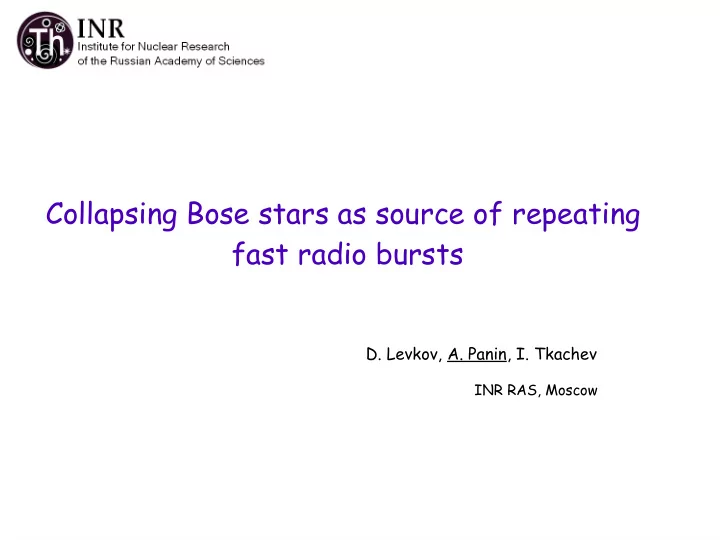

Collapsing Bose stars as source of repeating fast radio bursts D. Levkov, A. Panin, I. Tkachev INR RAS, Moscow
Fast radio bursts ● The first FRB 010724 was discovered by Duncan Lorimer and his student David Narkevic in 2007 [D.R. Lorimer et al., 2007] ● At present about 70 sources of FRB are registered (www.frbcat.org). FRB 121102 and FRB 180814 are repeating. 2
Fast radio bursts ● The first FRB 010724 was discovered by Duncan Lorimer and his student David Narkevic in 2007 [D.R. Lorimer et al., 2007] ● At present about 70 sources of FRB are registered (www.frbcat.org). FRB 121102 and FRB 180814 are repeating. FRB 121102 properties: ● Frequency: 1 – 8 GHz 1 – 8 GHz or 10 -6 - 10 -5 eV ● Duration: ~ 1-10 milliseconds ~ 1-10 milliseconds Size of the source: < 300 km ● Dispersion measure: ~ 580 pc cm ~ 580 pc cm -3 -3 Extragalactic origin ● Flux density: ~ 1 Jy ~ 1 Jy Total energy: 10 39 erg ~ 10 -15 Msun ● Strong activity during several hours 3
Fast radio bursts ● The first FRB 010724 was discovered by Duncan Lorimer and his student David Narkevic in 2007 [D.R. Lorimer et al., 2007] ● At present about 70 sources of FRB are registered (www.frbcat.org). FRB 121102 and FRB 180814 are repeating. FRB 121102 properties: Collapsing Bose star properties: ● Frequency: 1 – 8 GHz 1 – 8 GHz ● Made of DM axions with m ~ 10 -5 eV or 10 -6 - 10 -5 eV ● Duration: ~ 1-10 milliseconds ~ 1-10 milliseconds ● Size of the star ~100 km Size of the source: < 300 km ● Dispersion measure: ~ 580 pc cm ~ 580 pc cm -3 -3 Extragalactic origin ● Flux density: ~ 1 Jy ~ 1 Jy ● Bose star mass 10 -12 Msun Total energy: 10 39 erg ~ 10 -15 Msun ● Strong activity during several hours ● Strong activity during collapse 4
Bose stars Bose star formation observes in different models with axion-like dark matter. QCD axion Fuzzy dark matter Bose condensation by gravitational Bose stars appear during structure interactions in miniclusters. formation in the center of each galaxy. [H.-Y. Schive et al, 2014; J. Veltmaat et al 2018] [D. Levkov et al, 2018] [cf. P. Sikivie, Q. Yang, 2009] ; ; 5
Properties of Bose stars Nonrelativistic approximation for classical field: ; Gross-Pitaevskii-Poisson system Total mass: unstable! due to attractive self-interaction. Stability criterion [N.G. Vakhitov, A.A. Kolokolov, 1973] [P.H. Chavanis, 2011] 6 QCD axion
Bose star collapse Overcritical stars collapse! [D. Levkov et al, 2016; T. Helfer et al, 2016; J. Eby et al, 2016] The scaling symmetry appears: – scaling solution 7
Bose star collapse: relativistic regime Equation: Potential: [G.G. di Cortona et al, 2015] 8
Axion-photon coupling Axion field of Bose star oscillates coherently with time: May cause parametric resonance of photons! axion-photons coupling modified Maxwell’s equations Consider plane waves with frequency m/2 moving through the star along z-axis. – gauge slowly depend on x and t eikonal-like approximation In the nonrelativistic regime slowly changes on the size of the order of photon wavelength. 9
Linear resonance a->2γ satisfy another pair of Eqs. Boundary conditions: no waves coming from infinity! Substituting we obtain the boundary value problem for . 10
Linear resonance a->2γ For real and we have analytic solution: and where from boundary condition Beginning of the resonance! For general we can solve boundary-value numerically For solution have . 11
Spherically-symmetric approximation When the amplitude of produced electromagnetic field becomes large, back reaction on the Bose star must be taken into account. Unrealizable! Unrealizable! Bose star is much larger than the photon wavelength! One can try to make 3d numerical simulation. Time of the burst is much larger than the photon frequency. Collapsing self-similar solution is spherically-symmetric attractor. We numerically verified that it forms up in collapse of a Bose star perturbed by a large amplitude nonspherical perturbation. Spherically symmetric approximation for the axion field. 12
Equations for 3d simulation – modified Maxwell’s equations - gauge and where Decompose vectors E, H, B and D into spherical-vector harmonics: Solve equations for the {lm}-modes of these vectors and equation for the axion field numerically 13
Back reaction of photons Total energy current of radio-photons produced by Bose star in the model with distributed to one (blue) and to ten (red) {lm}-harmonics. 14
Numerical results for Axion field in the center of collapsing Bose star intersecting with one l = 1 harmonics in the model with and 15
First burst Back reaction of produced photons Collision of axions at the center 16
First burst Resonance is terminated Stopped to grow reaching some after axions scattering equilibrium value Total electromagnetic energy current 17
First burst Has not enough time to develop resonance during subsequent collapse. Resonance is terminated Stopped to grow reaching some after axions scattering equilibrium value Total electromagnetic energy current 18
First burst Two peaks of spectrum are due to velocities of axions falling to the Bose star center. 19
Second burst Resonance is terminated Stopped to grow reaching some after scattering of axions equilibrium value Total electromagnetic energy current 20
Second burst Compare with the results based on solving the boundary-value problem of our effective theory of the resonance 21
Second burst 22
Bursts parameters in the model with First burst Second burst Time delay between the bursts is 23
Resonance during Bose star collapse 1. Radio frequencies 2. Repeatability during several hours Collapse duration is of order of free fall time 3. Duration of one burst 4. Energy of one burst 24
Conclusion Very close to what we expect for dark matter made by QCD axion particles. 25
a a a a Thank you for attention! 26
Recommend
More recommend